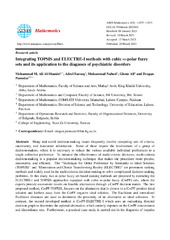Please use this identifier to cite or link to this item:
https://rfos.fon.bg.ac.rs/handle/123456789/2541| Title: | Integrating TOPSIS and ELECTRE-I methods with cubic m-polar fuzzy sets and its application to the diagnosis of psychiatric disorders | Authors: | Ali Al-Shamiri, M.M. Farooq, A. Nabeel, M. Ali, G. Pamučar, Dragan |
Keywords: | multi-criteria decision-making;comparative analysis;CmPF-TOPSIS approach;CmPF-ELECTRE-I approach;CmPF set | Issue Date: | 2023 | Publisher: | American Institute of Mathematical Sciences | Abstract: | Many real-world decision-making issues frequently involve competing sets of criteria, uncertainty, and inaccurate information. Some of these require the involvement of a group of decision-makers, where it is necessary to reduce the various available individual preferences to a single collective preference. To enhance the effectiveness of multi-criteria decisions, multi-criteria decision-making is a popular decision-making technique that makes the procedure more precise, reasonable, and efficient. The “Technique for Order Preference by Similarity to Ideal Solution (TOPSIS)” and “Elimination and Choice Transforming Reality (ELECTRE)” are prominent ranking methods and widely used in the multi-criteria decision-making to solve complicated decision-making problems. In this study, two m-polar fuzzy set-based ranking methods are proposed by extending the ELECTRE-I and TOPSIS approaches equipped with cubic m-polar fuzzy (CmPF) sets, where the experts provide assessment results on feasible alternatives through a CmPF decision matrix. The first proposed method, CmPF-TOPSIS, focuses on the alternative that is closest to a CmPF positive ideal solution and farthest away from the CmPF negative ideal solution. The Euclidean and normalized Euclidean distances are used to determine the proximity of an alternative to ideal solutions. In contrast, the second developed method is CmPF-ELECTRE-I which uses an outranking directed decision graph to determine the optimal alternative, which entirely depends on the CmPF concordance and discordance sets. Furthermore, a practical case study is carried out in the diagnosis of impulse control disorders to illustrate the feasibility and applicability of the proposed methods. Finally, a comparative analysis is performed to demonstrate the veracity, superiority, and effectiveness of the proposed methods. | URI: | https://rfos.fon.bg.ac.rs/handle/123456789/2541 | ISSN: | 2473-6988 |
| Appears in Collections: | Radovi istraživača / Researchers’ publications |
Show full item record
SCOPUSTM
Citations
6
checked on Nov 17, 2025
Page view(s)
6
checked on Dec 14, 2025
Download(s)
2
checked on Dec 14, 2025
Google ScholarTM
Check
Altmetric
This item is licensed under a Creative Commons License


